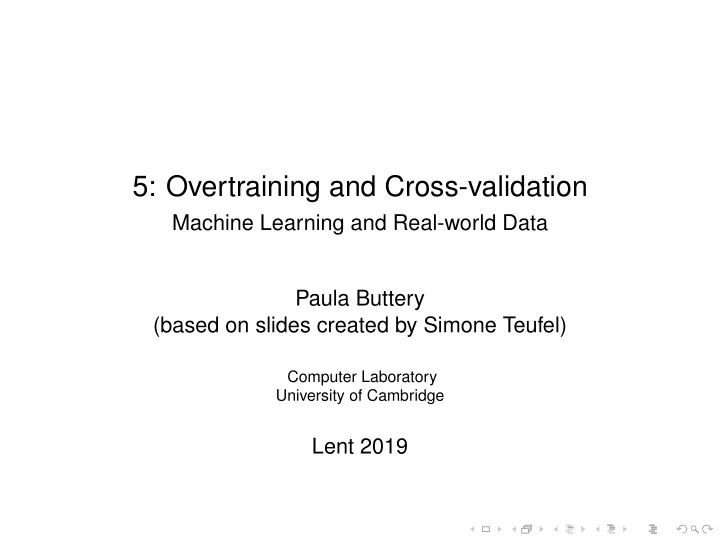

5: Overtraining and Cross-validation Machine Learning and Real-world Data Paula Buttery (based on slides created by Simone Teufel) Computer Laboratory University of Cambridge Lent 2019
Last session: smoothing and significance testing You have implemented various system improvements, e.g., concerning the (Laplace) smoothing parameter. You have investigated whether a manipulation leads to a statistically significant difference. Let us now think about what our NB classifier has learned: has it has learned that “excellent” is an indicator for positive sentiment? or has is learned that certain people are bad actors?
Ability to Generalise We want a classifier that performs well on new, never-before seen data. That is equivalent to saying we want our classifier to generalise well. In detail, we want it to: recognise only those characteristics of the data that are general enough to also apply to some unseen data ignore the characteristics of the training data that are specific to the training data Because of this, we never test on our training data, but use separate test data. But overtraining can still happen even if we use separate test data.
Overtraining with repeated use of test data You could make repeated improvements to your classifier, choose the one that performs best on the training / development data, and declare that as your final result. Overtraining is when you think you are making improvements (because your performance on the test data goes up) . . . . . . but in reality you are making your classifier worse because it generalises less well to data other than your test data. It has now indirectly also picked up accidental properties of the (small) test data.
Overtraining, the hidden danger Until deployed to real unseen data, there is a danger that overtraining will go unnoticed. One of the biggest dangers in ML: you have to be vigilant to notice that it’s happening performance “increases” are always tempting (even if you know they might be unjustified). Other names for this phenomenon: Overfitting Type III errors (correctly rejecting the null hypothesis, but for the wrong reason)
Am I overtraining? You can be confident you are not overtraining if you have large amounts of test data, and use new (and large enough) test data each time you make an improvement. You can’t be sure if you are overtraining if you make incremental improvements to your classifier and repeatedly optimise the system based on its performance on the same small test data. You have probably overtrained if you inspect the most characteristic features for each class (cf. starred tick) and find features that are unlikely to generalise
The “Wayne Rooney” effect One way to notice overtraining is by time effects. Time changes public opinion on particular people or effects. Vampire movies go out of fashion, superhero movies come into fashion. People who were hailed as superstars in 2003 might later get bad press in 2010 Called the “Wayne Rooney” effect You will test how well your system (trained on data from up to 2004) performs on reviews from 2015/6
Cross-validation: motivation We can’t afford getting new test data each time. We must never test on the training set. We also want to use as much training material as possible (because ML systems trained on more data are almost always better). We can achieve this by using every little bit of training data for testing – under the right kind of conditions. By cleverly iterating the test and training split around
N-Fold Cross-validation Split data randomly into N folds For each fold X – use all other folds for training, test on fold X only The final performance is the average of the performances for each fold
N-Fold Cross-validation Stratified cross-validation: a special case of cross-validation where each split is done in such a way that it mirrors the distribution of classes observed in the overall data. You can use your significance test as before, on all of the test folds → you have now gained more usable test data and are more likely to pass the test if there is a difference.
N-Fold Cross-Validation and variance between splits If all splits perform equally well, this is a good sign We can calculate variance: n var = 1 � ( x i − µ ) 2 n i x i : the score of the i th fold µ : avg i ( x i ) : the average of the scores
Data splits in our experiment Training set (1,600) Validation (development) set (200) – used up to now for testing Test set (200) – new today! Use training + validation corpus for cross-validation
First task today Implement two different cross-validation schemes: Random Random Stratified Observe results. Calculate variance between splits.
Second task today Use the precious test data for the first time (on the best system you currently have) Download the 2015/6 review data and run that system on it too (original reviews collected before 2004). Compare results with the accuracies from testing on the development set (significant?)
Literature James, Witten, Hastie and Tibshirani (2013). An introduction to statistical learning , Springer Texts in Statistics. Section 5.1.3 p. 181–183 ( k -fold Cross-Validation)
Recommend
More recommend